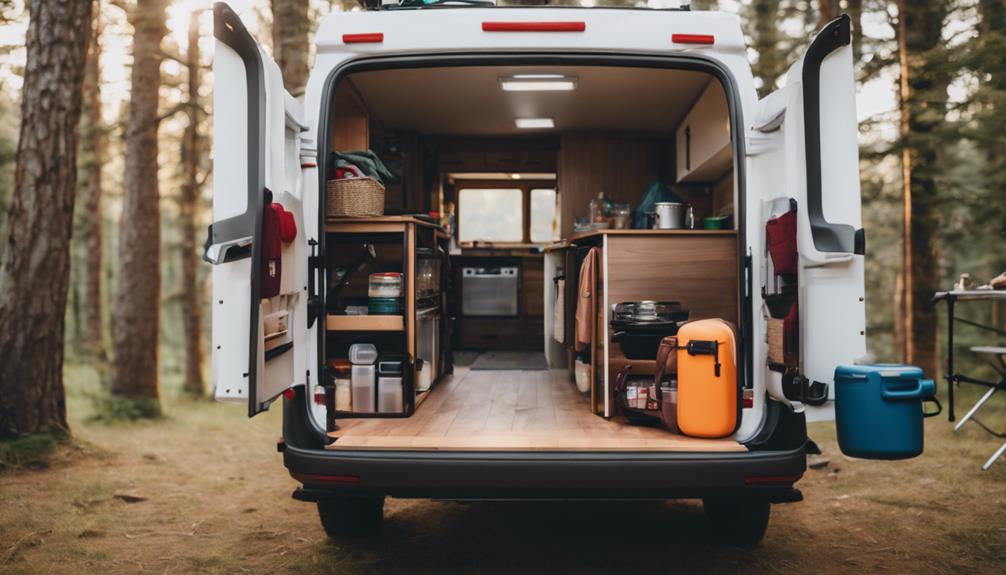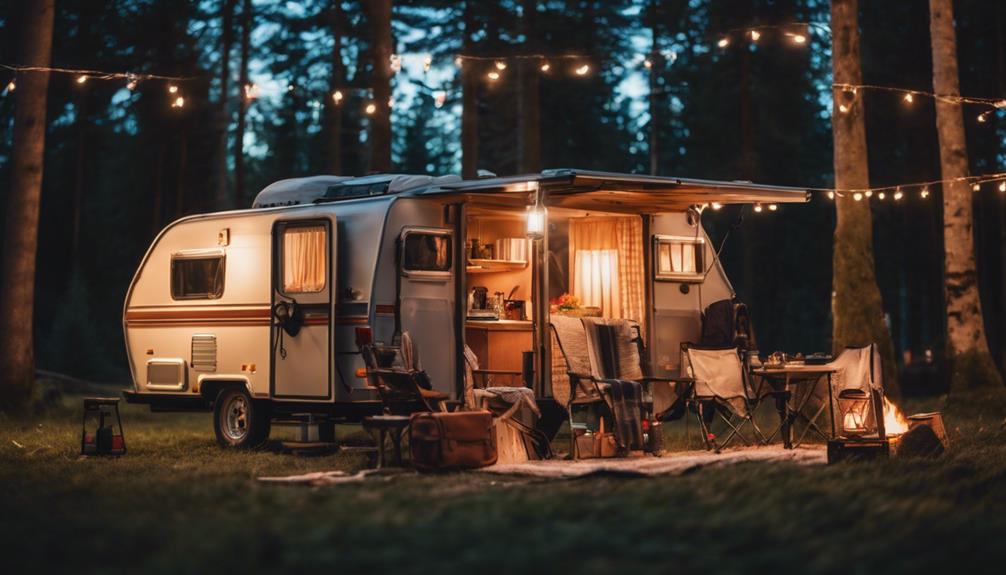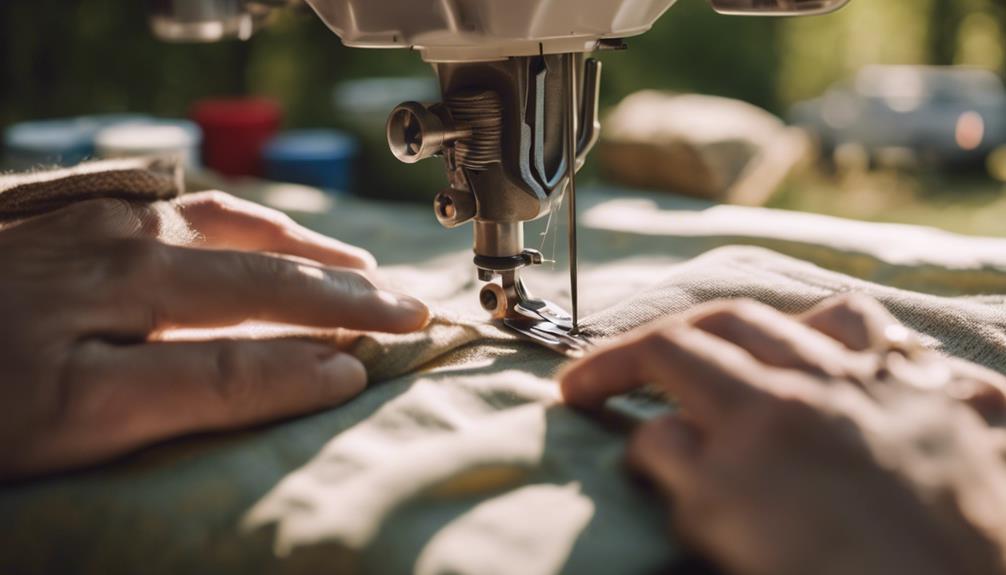To pack a pop-up camper efficiently, start by measuring your space and planning your layout. Focus on essentials, categorizing items to avoid clutter. Use space-saving bags for bedding and waterproof bins for kitchen supplies. Make sure to distribute weight carefully; place heavier items over the axles for stability. Utilize hidden storage areas under tables and seating, and keep frequently used gear accessible. Implement creative solutions like tension rods for hanging utensils. This thoughtful packing not only saves space but also enhances your camping experience. Stick around, and you'll discover even more tips for a hassle-free journey.
Key Takeaways
- Measure your camper's floor space and create a layout plan to maximize storage and organization for essential gear.
- Categorize items into essentials and non-essentials, focusing on necessity to simplify packing and reduce clutter.
- Use creative storage solutions like space saver bags, waterproof bins, and under-table storage to optimize space.
- Ensure proper weight distribution by placing heavier items over axles and storing lighter items towards the front and rear.
Importance of Efficient Packing
Efficient packing is essential for maximizing space in your pop-up camper, ensuring you have all the gear you need for a comfortable trip. Proper organization of your items not only helps you locate essentials quickly but also enhances your overall camping experience. When you pack thoughtfully, you reduce the time spent rummaging through boxes, allowing more time to enjoy your adventure.
To optimize your storage space, consider using plastic bins and vacuum-sealed bags. These solutions can greatly compress your belongings, making it easier to fit everything you need while minimizing clutter. As you pack, regularly assess the necessity of each item; this helps you avoid bringing along gear that isn't essential, lightening your load.
Additionally, a well-planned packing strategy contributes to better weight distribution in your camper. Properly distributing weight improves stability and safety while traveling, making your journey smoother.
Measuring and Planning Ahead
Before you start packing, measure the width and height of your camper's floor spaces to know where you can store your gear.
Assess what items you really need for your trip, focusing on essentials to maximize your packing efficiency.
This planning step will help you make the most of your space and keep your load manageable.
Measure Floor Space Dimensions
Measuring the width and height of your pop-up camper's floor space guarantees that all your gear fits snugly and safely during your trip. It's a good idea to measure the width of every storage area, like cupboards and under-bench spaces, so you know exactly how much room you have. This pre-packing step helps you make sure you're using the available space wisely.
Before you start loading your gear, list out the items you really need for your camping adventure. This way, you won't pack unnecessary things that could take up valuable space. Once you've identified your essentials, create a layout plan that accommodates both your must-haves and any extra items you might want to bring along.
Also, keep the maximum weight capacity of your camper in mind. Distributing items evenly helps maintain stability while you're on the road.
Regularly reassessing your packing strategy based on past trips can lead to better space management. By measuring and planning ahead, you'll enhance your overall camping experience, making your trips smoother and more enjoyable.
Assess Essential Item Needs
Evaluating your crucial item needs is important for maximizing space and ensuring a smooth camping experience. Start by measuring the width and height of your pop-up camper's floor spaces. This will help you determine the best layout for packing your gear. Identify what's essential for your trip and separate those items from non-essential ones.
Here's a quick list of essential items to reflect on:
- Sleeping bags
- Cooking gear
- Food supplies
- First aid kit
Once you know what you need, create a layout plan that takes into account weight distribution for stability during travel. Place heavier items lower and centered to keep your camper balanced.
As you pack, regularly evaluate the necessity of each item to reduce your overall load. This won't only simplify your packing process, but it'll also give everything a designated space for easy access while camping.
Creative Storage Solutions
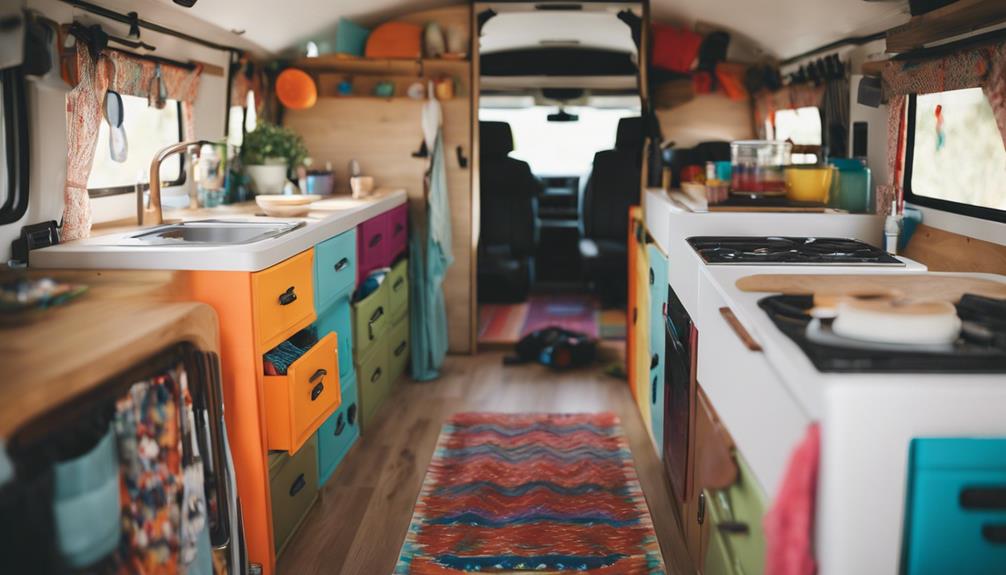
Maximizing storage in your pop-up camper requires creative solutions that make the most of every available space. Start by using space saver bags to compress your bedding. This not only reduces bulk but also frees up valuable room for other essentials.
For kitchen items, opt for plastic bins with tops; they're waterproof and airtight, protecting your dishes from moisture and pests.
Don't overlook under-table and seating areas; these spots can be perfect for hidden storage. By utilizing these often-wasted spaces, you can keep essential items close at hand while keeping your camper tidy.
Incorporate collapsible items like bowls and cooking gear to save space during travel. These versatile tools make meal prep easier without taking up too much room.
Organization of Camping Gear
After finding creative storage solutions, organizing your camping gear helps guarantee you have everything you need at your fingertips when you're on the road.
Effective organization makes packing quick and easy, so you can focus on enjoying your camping experience. Here are some tips and tricks to keep your gear in order:
- Use plastic drawer units for each family member's clothing.
- Store dish-related items and cooking supplies under the table.
- Incorporate tension rods for hanging towels and utensils.
- Use waterproof and airtight containers for dry goods.
Space Management Techniques
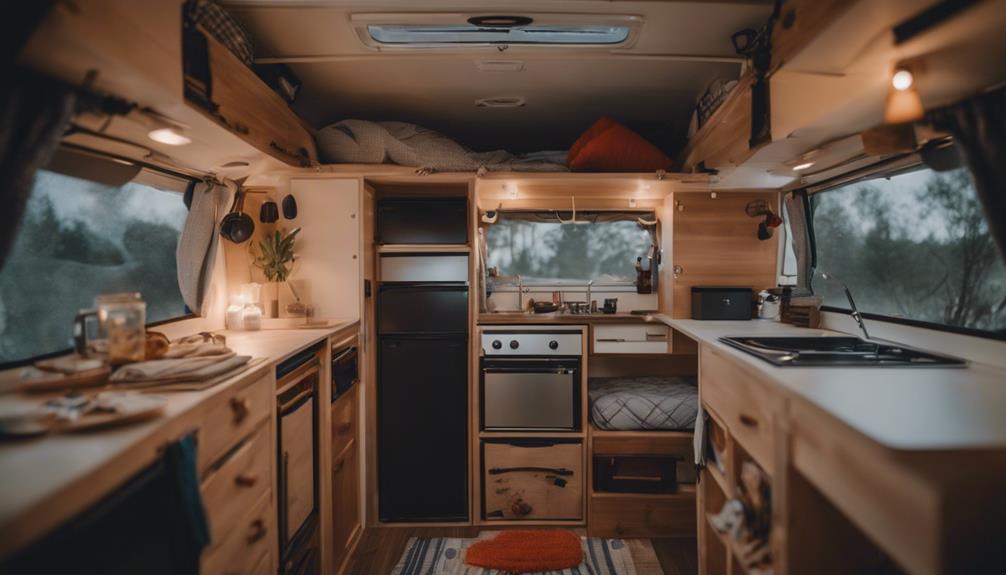
When packing your pop-up camper, effective layout planning is essential for maximizing space.
You'll want to take into account weight distribution to keep your camper balanced and stable.
Identifying essential items helps streamline your packing process, ensuring you have what you need without overcrowding.
Effective Layout Planning
Effective layout planning is essential for ensuring your pop-up camper is organized and functional, allowing you to enjoy your trips without the hassle of clutter. Start by measuring the width and height of your camper's floor spaces to create a precise layout plan that maximizes available storage.
Here are some effective space management techniques to contemplate:
- Utilize under-table and bench areas for extra storage.
- Stack shorter items like linens on plastic bins for optimized vertical space.
- Designate specific areas for kitchen supplies, camping gear, and personal belongings.
- Regularly reassess your packing strategy to eliminate unnecessary items.
Weight Distribution Considerations
Balancing weight distribution in your pop-up camper is just as important as planning its layout, guaranteeing a stable and safe towing experience. Proper weight management means placing heavier items directly over the axles and lighter items towards the front and rear. This arrangement enhances stability during travel, reducing the chances of swaying while your tow vehicle is in motion.
When packing, use plastic bins to store gear, and consider that an 8-foot pop-up camper can hold four bins alongside a porta potty. Stack shorter items, like linens and shelving, on top of the bins to lower the center of gravity. This not only optimizes space but also further stabilizes your camper.
Regularly evaluate what you truly need for your trip. Overloading can negatively impact braking and handling, making it essential to avoid excess weight. Aim for an even distribution of weight across both sides of the camper to minimize tipping risks.
Essential Item Identification
Identifying essential items for your pop-up camper trip helps streamline your packing process and maximizes available space. Start by measuring the width and height of the camper's floor spaces. This way, you can tailor your packing strategy for ideal space usage.
Next, categorize your items into essential and non-essential. This will reduce unnecessary weight and guarantee you only take what you really need. Keep a detailed inventory of essential items to track your packing efficiently.
Here are some essentials to take into account:
- Sleeping bags
- Cooking utensils
- Food supplies
- Camping chairs
Utilize vertical space by stacking shorter items on top of bins and storing items under tables and seats. This not only maximizes available storage but also keeps your camper organized.
Remember to evaluate weight distribution carefully during packing to maintain stability while towing. Regularly reassess your inventory and packing strategy to identify areas for improvement.
Kitchen and Cooking Setup
A well-organized kitchen setup in your pop-up camper can make cooking enjoyable and efficient during your camping adventures. Start by implementing a solid meal planning strategy to minimize food waste and cut down on eating out. This approach not only saves money but also enhances convenience when preparing meals.
When it comes to kitchen items, consider using collapsible bowls and a compact waffle iron. These versatile cooking options save space while allowing you to whip up a variety of meals. Organize your kitchen with DIY storage solutions, like overhead compartments above the oven and sink, to keep essential items within easy reach.
To prevent clutter, use Command Hooks inside cabinet doors for hanging utensils, ensuring they're always accessible. Designate specific drawers for flatware and cooking tools, while larger drawers can store pots, pans, and dishes. This organization maximizes your kitchen space and keeps everything tidy.
With these tips, you'll create an efficient cooking setup that enhances your camping experience, making it easier to enjoy delicious meals under the stars. Happy camping!
Bathroom and Toiletry Storage
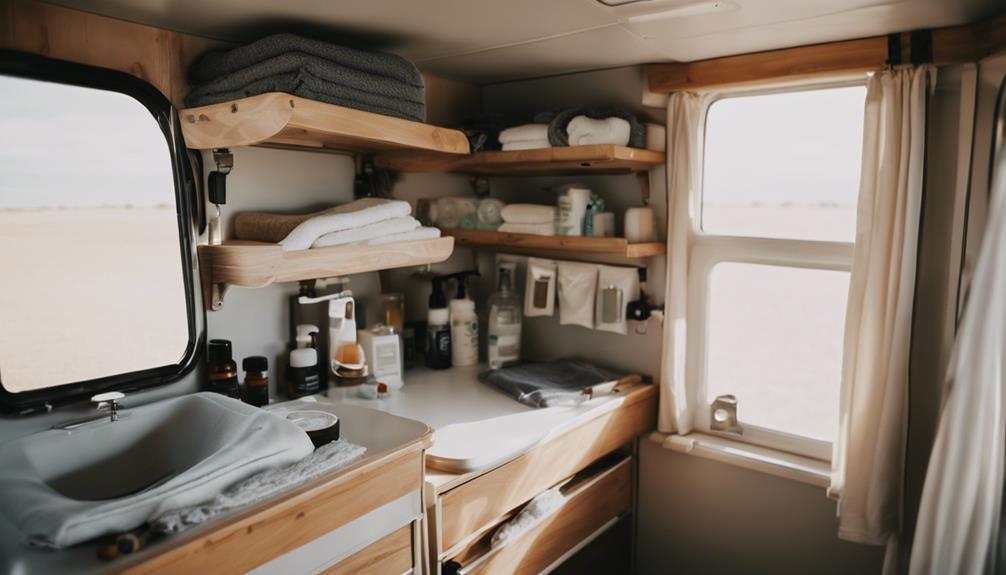
Maximizing bathroom and toiletry storage in your pop-up camper enhances convenience and keeps your space organized for a more enjoyable camping experience. To achieve effective toiletries organization, consider a few practical solutions that cater to everyone's needs.
Use tension rod shelving above the cassette toilet cabinet for easy access to essentials.
Assign smaller Sterilite 3-drawer units for each family member to store personal items, avoiding mix-ups during trips.
Create a shared drawer for communal items like toothpaste and floss, using dollar store baskets for organization.
Store shower supplies in handy bags and attach shower lanyards to keep everything together during shower time.
Hang bath towels on towel bars under bunkends for quick drying and easy access.
Maintenance and Upkeep Tips
Keeping your pop-up camper in top shape requires regular maintenance alongside the thoughtful organization of your bathroom and toiletry storage. Start with routine checks on seals, canvas, and other components. By doing this, you can prevent leaks and water damage, which can be costly to repair and shorten your camper's lifespan.
Deep cleaning your pop-up camper at least twice a year is essential, especially for older units. Make certain to reach those hard-to-access areas where mold and mildew can hide. This habit not only maintains your camper's condition but also keeps it smelling fresh.
A well-stocked toolbox is a must-have for any camper. Keep essential repair items like grease guns and patch kits handy. This way, you'll be prepared for minor repairs during your trips, guaranteeing a smooth and enjoyable experience.
Lastly, create laminated supply lists for all your camper essentials and food staples. This helps streamline your packing process and guarantees you never forget anything important.
With these maintenance and upkeep tips, your pop-up camper will remain ready for adventure whenever you are!
Frequently Asked Questions
Where to Put Your Clothes in a Pop-Up Camper?
You can store clothes in a plastic three-drawer dresser, use Rubbermaid tubs for stacking, or install tension rods for hanging. Don't forget to utilize under-bench areas for extra storage and keep everything organized!
How Do You Pack a Camper Efficiently?
Packing a camper efficiently's like crafting a masterpiece; every inch matters. Measure spaces, use vacuum bags, and stash items wisely. Regularly reassess your gear, keep essentials accessible, and let creativity guide your organization.
How Do You Pack a Pop Up?
To pack a pop-up, measure your spaces and use storage solutions like Space Saver Bags and bins. Organize items by category, keep essentials accessible, and regularly reassess your packing to streamline your experience.
What Is the Best Way to Pack a Camper Trailer?
Packing a camper trailer's like crafting a well-tuned symphony; every item plays its part. Prioritize space, use organized bins, and designate zones to create harmony and comfort for your adventures. Simplify, reassess, and enjoy!
What are the Efficient Packing Tips for Lowering and Packing Up a Pop-Up Camper Safely?
When preparing to lower popup camper safely.for travel, it’s essential to pack efficiently. Start by organizing items, placing heavier gear on the bottom, and lighter items on top. Distribute weight evenly to maintain balance and stability on the road. Secure loose items to prevent shifting while in motion.
Conclusion
Packing your pop-up camper efficiently is like assembling a puzzle; every piece has its place to create a perfect picture of adventure.
By measuring, planning, and utilizing creative storage solutions, you can maximize your space and keep your gear organized.
Remember, a well-packed camper not only makes travel smoother but also enhances your camping experience.
So, gear up, pack smart, and hit the road for unforgettable memories under the stars!

